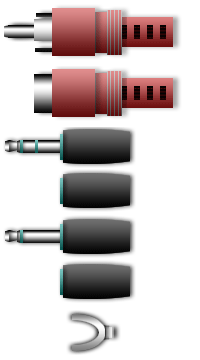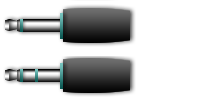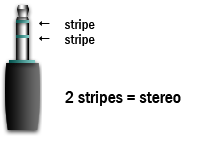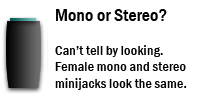|
 In
this section, we're going to learn some important things about audio cables
and the various kinds of connecting widgets that appear on the ends of those
cables. In
this section, we're going to learn some important things about audio cables
and the various kinds of connecting widgets that appear on the ends of those
cables.
At left are all the kinds of connectors that we will be covering in this
lesson. This set of connectors is all that is required to connect our phonograph
player to our stereo receiver, and our stereo receiver to our sound card.
Maybe you can already identify all of these connection types, but if not,
you will be able to do so by the time you're done with this lesson. It's
not too hard, so let's get started.
Cable Gender: Male And Female
Connectors have gender and the rule is pretty much what you'd expect:
Connectors with "prongs" = "male"
Connectors with "holes" = "female"
Types of Connectors
Although there are seven different connectors shown in our picture, these
all belong to one of three connection types: RCA, 1/8th-inch mini jack, and
a phonograph ground wire connector. Each has a male and female variant, except
for the phono ground connector. The minijack connector also has monoaural
and stereo variants, in addition to its male and female variants. Here's
Professor Whozawitts' handy guide:
RCA Connectors
 This
connector is an RCA (male) connector. It is a very common
kind of connector. Most stereo receivers have input jacks for this kind of
connector, and that's where we'll be using it most -- to get the audio signal
into and out of our stereo (or A/V surround-sound) receiver. This
connector is an RCA (male) connector. It is a very common
kind of connector. Most stereo receivers have input jacks for this kind of
connector, and that's where we'll be using it most -- to get the audio signal
into and out of our stereo (or A/V surround-sound) receiver.
 This
connector is an RCA (female) connector. We actually won't be using this connector
in our setup, but you should know that they exist. Instead of the prong,
the female RCA connector has a hole. The prong fits into the hole, and the
metal tabs (the things that look like cannon-mounts from a castle-tower)
grip the outside of the metal jack at the tip of the female RCA connector
in exactly the same way as they do when we plug a male RCA connector into
a female jack on the back of our receiver. This
connector is an RCA (female) connector. We actually won't be using this connector
in our setup, but you should know that they exist. Instead of the prong,
the female RCA connector has a hole. The prong fits into the hole, and the
metal tabs (the things that look like cannon-mounts from a castle-tower)
grip the outside of the metal jack at the tip of the female RCA connector
in exactly the same way as they do when we plug a male RCA connector into
a female jack on the back of our receiver.
Minijack Connectors
 As
we mentioned earlier, the minijack connectors come in both mono and stereo
variants. We'll talk about those differences in a moment. But for now, note
that the minijack connectors with prongs are the male ones, just as you'd
expect. As
we mentioned earlier, the minijack connectors come in both mono and stereo
variants. We'll talk about those differences in a moment. But for now, note
that the minijack connectors with prongs are the male ones, just as you'd
expect.
 And,
also as expected, the minijack connectors with holes are called female. We
won't be using cables with female minijack connectors, though we will be
seeing them on our soundcard. And,
also as expected, the minijack connectors with holes are called female. We
won't be using cables with female minijack connectors, though we will be
seeing them on our soundcard.
Phono Ground
 The
phono ground connector is used to connect the phonograph player's ground
wire to receiver's ground wire in order to help prevent audible hum that
can come from connecting together equipment with mismatched electrical ground
values. The ground wire and its associated connector are therefore fundamentally
different from the other cables under discussion in this section, because
they do not carry audio signals. Concepts like "stereo" and "mono" don't
apply to the phono ground connector. Similarly, they don't come in "male" and "female" variants
either. The
phono ground connector is used to connect the phonograph player's ground
wire to receiver's ground wire in order to help prevent audible hum that
can come from connecting together equipment with mismatched electrical ground
values. The ground wire and its associated connector are therefore fundamentally
different from the other cables under discussion in this section, because
they do not carry audio signals. Concepts like "stereo" and "mono" don't
apply to the phono ground connector. Similarly, they don't come in "male" and "female" variants
either.
Usually the phono ground wire is part of your phonograph, with only the
end that connects to the receiver unattached. Since its shape is unique,
there is usually only one obvious place to attatch it to the receiver. The
only other jack on the back of most receivers that looks anything like the
phono ground is the FM antenna plate. But these are easy to distinguish if
you just remember that the phono ground has only one connector, while the
FM antenna has two.
Mono And Stereo
Some connectors, like the RCA connector, are inherently mono -- if you want
to convey a stereo signal with these connectors you have to use two of them:
one for the left channel and one for the right.
 But
the minijack connector is an example of a connector that has both a mono
and stereo version. On the male minijack, you can distinguish the mono from
the stereo by noting how many stripes are on the prong. But
the minijack connector is an example of a connector that has both a mono
and stereo version. On the male minijack, you can distinguish the mono from
the stereo by noting how many stripes are on the prong.
One stripe means it's a mono connector.
Two stripes means stereo.
 Unfortunately,
there's no such simple visual key for figuring out whether a female minijack
connector is capable of conveying a stereo signal, or only a mono signal.
The stereo and mono female minijack connectors look identical. The only way
to be sure which is which is to try them out and let your ears be the judge.
If you hear a stereo image, with different sounds coming from the left and
right, then the female minijack connector must be stereo. If not, it's mono. Unfortunately,
there's no such simple visual key for figuring out whether a female minijack
connector is capable of conveying a stereo signal, or only a mono signal.
The stereo and mono female minijack connectors look identical. The only way
to be sure which is which is to try them out and let your ears be the judge.
If you hear a stereo image, with different sounds coming from the left and
right, then the female minijack connector must be stereo. If not, it's mono.
On the other hand, even though there is no "for sure" way of distinguishing
them by sight, a good hint can come from looking at what kind of connector
is at the other end of the cable. If a cable has a female minijack at one
end,
and
a pair of RCA jacks at the other, it is likely that the minijack is stereo.
On the other hand, if there is a mono male minijack at the other end, then
the female minijack is probably mono. The rule of thumb here is that one
can make a good guess about whether a female minijack is mono or stereo by
seeing whether the opposite end of the cable is designed for a mono or stereo
signal. Most of the time cables are designed to transport audio signals,
not modify them. So if the cable supports stereo at one end, it's more likely
than not to support stereo at the other end too.
That's about all we need to know about cable nomenclature. Let's test out
our newfound knowledge!
|

